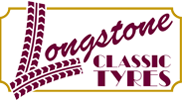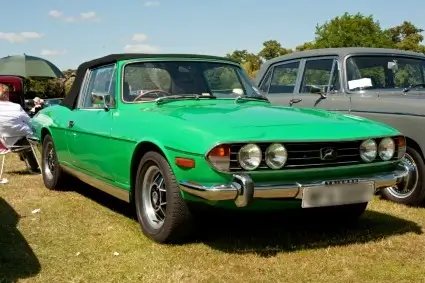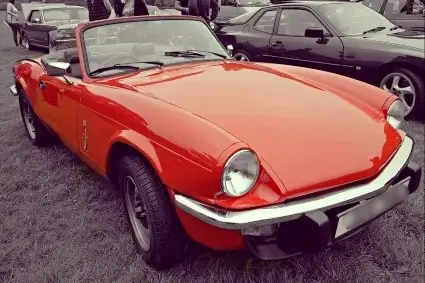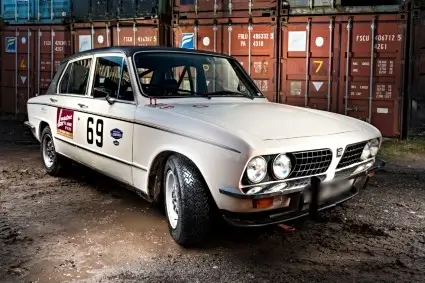-
- Triumph Dolomite Tyres
- Triumph Roadster Tyres
- Triumph Renown Tyres
- Triumph TR2 Tyres
- Triumph TR3 Tyres
- Triumph Herald Tyres
- Triumph TR4 Tyres
- Triumph Spitfire Tyres
- Triumph Vitesse Tyres
- Triumph 2000 Tyres
- Triumph GT6 Tyres
- Triumph TR5 Tyres
- Triumph TR6 Tyres
- Triumph Toledo Tyres
- Triumph Stag Tyres
- Triumph 1500 Tyres
- Triumph TR7 Tyres
- Triumph 1300 Tyres
- Triumph TR8 Tyres
Triumph Tyres
Classic Triumph Tyres
On the following pages, Longstone Classic Tyres give classic tyre fitment recommendations for Triumph cars.
Or take advantage of our brief Triumph Tyre Fitment Guide.
Michelin XAS Tyres and Triumph
The legendary handling of the asymmetric Michelin XAS tyres was not wasted on Triumph. They fitted 165HR15 XAS to their TR6 as a simple way of dramatically improving the handling. So impressed by the effects were Triumph that they downsized the tyres on the Stag, which originally fitted 185R14, Triumph found the handling so much better with the XAS that from 1976 they fitted 175R14 Michelin XAS as standard.
Triumph TR2 Racing
The boss of Longstone Tyres was fortunate to be offered the opportunity by a fellow Frazer Nash owner, Brian White, to share a race in his TR2 at the fantastic Portimao Circuit in the Algarve, of course, the car would be fitted with ideal Triumph racing tyres. It was an opportunity for a family holiday. The Triumph, on its racing tyres, was trailered down to the event behind the family car full of Triumph tools, tyre equipment and children. Longstone Tyres were pretty much the only racing team who were fettling their own car and had transported their own car. (The other Triumph there was Charles Gillett). The race was fantastic as you can see from this film. The little factory-built Triumph up against all sorts of exotic bespoke racing cars like Lister Jaguars, Lotus 11, Ferrari Testarossa, etc.
Triumph Racing Tyres
As you can see from the film having the right tyres on the Triumph TR2 keeps the car handling beautifully. The Triumph TR2 in this film was fitted with Dunlop cross ply Racing Tyres. The Tyre size was 550 - 15. You can see how progressively the car handles in the film (there is some twitchy turning in. This is down to driver error, attempting to turn in too early). The original tyre size for a Triumph TR2 is 5.50 - 15. It is this progressive handling that is lost when over tyring a car. Because of this, if you want to fit radial tyres to your Triumph TR2 we recommend sticking with a genuine period tyre, the PIRELLI CINTURATO ™;, of a similar size radial tyre 155HR15.
If your car is not listed, don't panic! Please give us a call on:
01302 711 123
or
Email: sales@longstonetyres.co.uk
Triumph History
Siegfried Bettmann of Nuremberg founded S. Bettmann & Co. in 1885 and began procuring bicycles from Europe and looking to sell them in London under his own trade name. The company name was changed to "Triumph" the following year, and Bettmann was joined by another German partner, Moritz Schulte, in 1887. In Coventry, England, merchants began constructing their own bicycles in 1889.
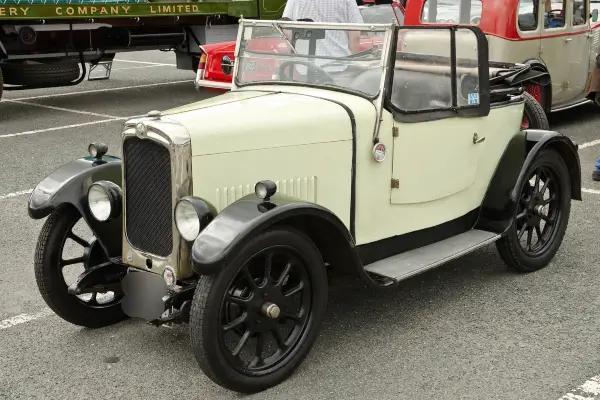
In 1902, they began making Triumph bikes at their factory on Much Park Street in Coventry. Initially, they used engines acquired from another manufacturer, but as the business grew, they began manufacturing their own engines. In 1907, they bought the Priory Street buildings of a spinning mill to build a new business. During World War I, the British Army made huge orders for the 550 cc Model H; by 1918, Triumph was becoming Britain's largest motorcycle manufacturer.
Bettmann was persuaded in 1921 by his general manager, to purchase the Dawson Car Company's assets and Clay Lane premises and start manufacturing a car and 1.4-litre motor dubbed the Triumph 10/20 developed for them by Lea-Francis, who received a royalty for every car sold. The manufacturing of this automobile and its immediate predecessors was modest, but this shifted with the debut of the Triumph Super 7 in 1927, which sold well until 1934.
The company name was changed to Triumph Motor Company in 1930. Holbrook realised he couldn't compete in the mass market with the major car firms, so he chose to create pricier automobiles, introducing the Southern Cross and Gloria models. Initially, they utilised engines produced by Triumph but developed by Coventry Climax, but in 1937, Donald Healey, the company's experimental manager since 1934, began producing engines to his own designs. However, the firm ran into financial difficulties, and the Triumph bicycle and motorcycle companies were sold in 1936. Healey bought an Alfa Romeo 8C 2300 and created the Triumph Dolomite, a vehicle with an Alfa-inspired straight-8 engine. In 1934, three of these vehicles were built, one of which was utilised in competition but was destroyed in an accident. The Dolomites produced between 1937 and 1940 had little in common with these prototypes.
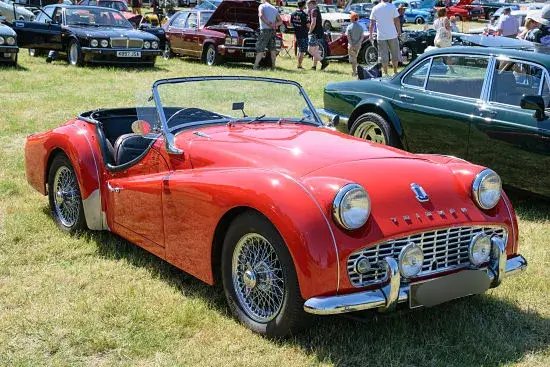
The Triumph Motor Company fell into receivership in July 1939. The Thos. W. Ward scrapping firm bought Triumph and put Healey in charge as general manager, but the impacts of WWII halted manufacturing once more; the Holbrook Lane plant was entirely devastated by bombing in 1940. In November 1944, the Standard Motor Company purchased what remained of the Triumph Motor Company and the Triumph trade name, and a subsidiary "Triumph Motor Company (1945) Limited" was founded, with manufacture shifted to Standard's facility at Canley, on the outskirts of Coventry. Since 1938, Triumph's new owners supplied motors to Jaguar and its precursor business.
The pre-war Triumph models were not resurrected, and a new line of Triumphs were introduced in 1946, beginning with the Triumph Roadster. Because steel was in scarce supply and excess aluminium from aircraft manufacture was abundant, the Roadster's body was made of aluminium. The same engine was utilised in the 1800 Town and Country saloon, which was subsequently renamed the Triumph Renown and was renowned for the style chosen by Standard-Triumph managing director Sir John Black. A similar design was adopted for the Triumph Mayflower light saloon that followed. When Sir John was forced to depart from the firm, this line of automobiles was retired without being immediately replaced, sheet aluminium having become an unacceptably costly option to compared sheet steel for most auto-industry applications by this point.
It was agreed in the early 1950s to use the Triumph name for sporting vehicles and the Standard name for saloons, and in 1953 the Triumph TR2 was introduced, the first TR series of sports cars manufactured until 1981. Surprisingly, the TR2 had a Standard emblem on the front and a Triumph globe on the hubcaps. Standard had been producing a line of compact saloons known as the Standard Eight and Ten, and they were working on replacements. Triumph was deemed a more marketable brand than Standard due to the popularity of the TR family, and the new automobile was presented in 1959 as the Triumph Herald. The final Standard automobile produced in the United Kingdom was replaced in 1963 by the Triumph 2000.
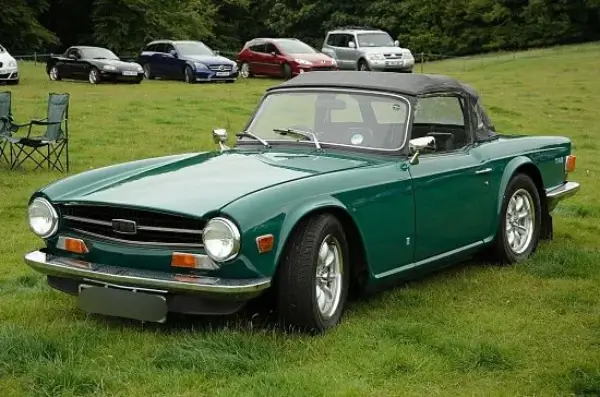
Leyland Motors Ltd. purchased Standard-Triumph in December 1960, and Donald Stokes was appointed chairman of the Standard-Triumph division in 1963. In 1968, Leyland combined with British Motor Holdings (formed two years previously by the merging of British Motor Corporation and Jaguar), resulting in the establishment of British Leyland Motor Corporation. Triumph established an assembly plant at Speke, Liverpool, in 1959, eventually expanding the firm's most modern factory to the point where it could make 100,000 cars per year. However, only a total of 30,000 automobiles were ever built because the factory was never fully operational, instead serving mostly as an assembly plant. Throughout the 1960s and 1970s, Triumph sold a series of Michelotti-styled saloons and sports cars, such as the sophisticated Dolomite Sprint, which had a 16-valve four-cylinder engine by 1973.
Many Triumphs of this era are said to have been unreliable, particularly the 2.5 PI (petrol injection) with its fuel injection issues. The summer heat in Australia caused petrol in electric fuel pumps to vaporise, resulting in recurrent problems. Although the injection technology had established itself in international competition, it required altitude adjustment, which would allow the fuel mixture to be adjusted at heights more than 3,000 feet above sea level.
Except for a brief period in the mid-1970s when all BL's automobile marques or brands were united together under the name Leyland Cars, the Triumph marque belonged to the company's Specialist Division, which went by the names Rover Triumph and subsequently Jaguar Rover Triumph. The TR7 was the only all-new Triumph model launched as Rover Triumph, and it was produced at three factories that were closed in succession. When the road car division of the Solihull facility was decommissioned, the four-cylinder TR7 and the eight-cylindered variant, the TR8, were phased out.
The last Triumph vehicle was the Acclaim, which was released in 1981 and was effectively a rebadged Honda Ballade made under licence from Honda at the old Morris Motors plant in Cowley, Oxford. The Triumph brand was discontinued in the summer of 1984 when the Acclaim was replaced by the Rover 200, a rebranded version of Honda's next-generation Civic/Ballade. This was the first stage in the Rover Group's rebranding, which would see the Austin and Morris trademarks disappear by the end of the 1980s and the Rover brand dominated the majority of the company's goods. The BL automobile sector had been renamed the Austin Rover Group at that point, and it also phased out the Morris and Triumph brands in 1984.
Triumph Tire Fitment Guide
| Model name | Engine | Year | Tyre |
|---|---|---|---|
| Gloria Four and Six | - | 1933–1938 | 6.00-16 PIRELLI STELLA BIANCA |
| Triumph 1800 Saloon & Roadster | 1776 cc inline 4 | 1946–1948 | 6.00-16 PIRELLI STELLA BIANCA |
| Triumph 2000 Saloon | 2088 cc inline 4 | 1949 | 6.00-16 PIRELLI STELLA BIANCA |
| Triumph 2000 Roadster | 2088 cc inline 4 | 1948–1949 | 6.00-16 PIRELLI STELLA BIANCA |
| Triumph Renown | 2088 cc inline 4 | 1949–1954 | 6.00-16 PIRELLI STELLA BIANCA |
| Triumph Mayflower | 1247 cc inline 4 | 1949–1953 | 155 TR 15 Michelin X 165 SR 15 Michelin XZX |
| Triumph TR2 | 1991 cc inline 4 | 1953–1955 | 155 HR 15 PIRELLI CINTURATO CA67 |
| Triumph TR3 | 1991 cc inline 4 | 1956–1958 | 155 HR 15 PIRELLI CINTURATO CA67 |
| Triumph TR3A | 1991 cc inline 4 | 1958–1962 | 165 HR 15 PIRELLI CINTURATO CA67 |
| Triumph Italia | 1991 cc inline 4 | 1959–1962 | 165 HR 15 PIRELLI CINTURATO CA67 |
| Triumph TR4 | 2138 cc inline 4 | 1961–1965 | 165 HR 15 PIRELLI CINTURATO CA67 |
